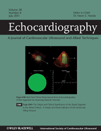Double Atrial Septal Defect: Diagnosis and Closure Guidance with 3D Transesophageal Echocardiography
Abstract
Atrial septal defect (ASD) is a common form of congenital heart disease that often persists well into adulthood before discovery or intervention. The authors report the case of a patient referred for routine percutaneous ASD closure that was found on three-dimensional (3D) transesophageal echocardiography to have two large separate ostium secundum defects which were subsequently closed under 3D echocardiographic guidance. (Echocardiography 2011;28:E115-E117)




